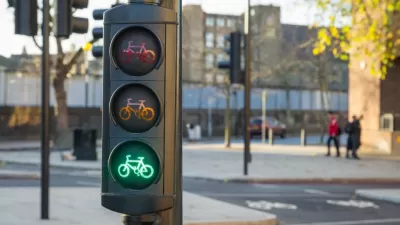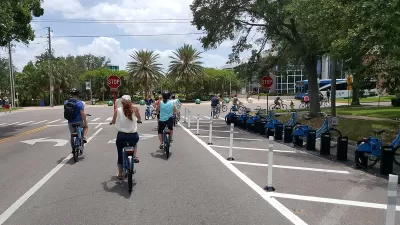Greg Beato enumerates how American bike-sharing programs fall short of their Parisian counterparts. Until the program evolves some more, the autonomy afforded by the private car or bicycle will continue to prevail.
"In giving up some of the autonomy you'd enjoy if you simply rode your own bike, you get other significant benefits in return, right? Well, someday perhaps. One thing that makes bike-sharing programs attractive, in theory at least, is that the bikes aren't yours. Bike theft is rampant pretty much everywhere there are bikes, and secure places to lock your trusty steed, especially for hours at a time, are exceedingly rare.
Offloading the risk of theft to a bike-sharing program makes sense-but in the case of SmartBike D.C., there's only so much risk you can offload. When a bike is safely locked in a docking station, you aren't responsible for anything that happens to it. Unlike Paris, however, D.C.'s docking stations are far from ubiquitous and aren't likely to achieve that state any time soon. (And even in Paris, bike theft remains a problem. Approximately 3000 Velib bikes were stolen and another 3000 vandalized during the program's first year of operation-some Velib bikes have reportedly been spotted as far away as Casablanca.)
In the case of SmartBike, if you want to run an errand in a part of the city where there are no official docking stations-aka most parts of the city-you assume the liability when you lock up the bike. If someone steals it on your watch, you owe SmartBike $550. If someone vandalizes it, you owe SmartBike however much it decides to charge you for the necessary repairs."
FULL STORY: My Other Bike is a Public Transportation System

Planetizen Federal Action Tracker
A weekly monitor of how Trump’s orders and actions are impacting planners and planning in America.

Maui's Vacation Rental Debate Turns Ugly
Verbal attacks, misinformation campaigns and fistfights plague a high-stakes debate to convert thousands of vacation rentals into long-term housing.

San Francisco Suspends Traffic Calming Amidst Record Deaths
Citing “a challenging fiscal landscape,” the city will cease the program on the heels of 42 traffic deaths, including 24 pedestrians.

Amtrak Rolls Out New Orleans to Alabama “Mardi Gras” Train
The new service will operate morning and evening departures between Mobile and New Orleans.

The Subversive Car-Free Guide to Trump's Great American Road Trip
Car-free ways to access Chicagoland’s best tourist attractions.

San Antonio and Austin are Fusing Into one Massive Megaregion
The region spanning the two central Texas cities is growing fast, posing challenges for local infrastructure and water supplies.
Urban Design for Planners 1: Software Tools
This six-course series explores essential urban design concepts using open source software and equips planners with the tools they need to participate fully in the urban design process.
Planning for Universal Design
Learn the tools for implementing Universal Design in planning regulations.
Heyer Gruel & Associates PA
JM Goldson LLC
Custer County Colorado
City of Camden Redevelopment Agency
City of Astoria
Transportation Research & Education Center (TREC) at Portland State University
Jefferson Parish Government
Camden Redevelopment Agency
City of Claremont




























